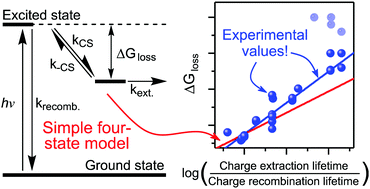Dynamics of photoconversion processes: the energetic cost of lifetime gain in photosynthetic and photovoltaic systems†
Abstract
The continued development of solar energy conversion technologies relies on an improved understanding of their limitations. In this review, we focus on a comparison of the charge carrier dynamics underlying the function of photovoltaic devices with those of both natural and artificial photosynthetic systems. The solar energy conversion efficiency is determined by the product of the rate of generation of high energy species (charges for solar cells, chemical fuels for photosynthesis) and the energy contained in these species. It is known that the underlying kinetics of the photophysical and charge transfer processes affect the production yield of high energy species. Comparatively little attention has been paid to how these kinetics are linked to the energy contained in the high energy species or the energy lost in driving the forward reactions. Here we review the operational parameters of both photovoltaic and photosynthetic systems to highlight the energy cost of extending the lifetime of charge carriers to levels that enable function. We show a strong correlation between the energy lost within the device and the necessary lifetime gain, even when considering natural photosynthesis alongside artificial systems. From consideration of experimental data across all these systems, the emprical energetic cost of each 10-fold increase in lifetime is 87 meV. This energetic cost of lifetime gain is approx. 50% greater than the 59 meV predicted from a simple kinetic model. Broadly speaking, photovoltaic devices show smaller energy losses compared to photosynthetic devices due to the smaller lifetime gains needed. This is because of faster charge extraction processes in photovoltaic devices compared to the complex multi-electron, multi-proton redox reactions that produce fuels in photosynthetic devices. The result is that in photosynthetic systems, larger energetic costs are paid to overcome unfavorable kinetic competition between the excited state lifetime and the rate of interfacial reactions. We apply this framework to leading examples of photovoltaic and photosynthetic devices to identify kinetic sources of energy loss and identify possible strategies to reduce this energy loss. The kinetic and energetic analyses undertaken are applicable to both photovoltaic and photosynthetic systems allowing for a holistic comparison of both types of solar energy conversion approaches.

- This article is part of the themed collection: Advances in Solar Energy Conversion


 Please wait while we load your content...
Please wait while we load your content...